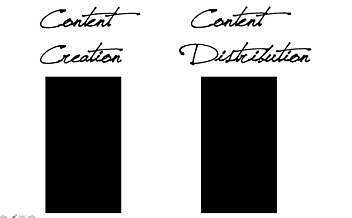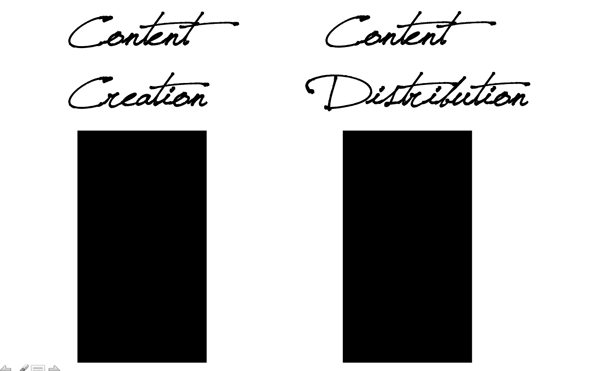If you think you’re done when the stuff’s written and posted, you’re wrong.
Rupert Murdoch still struggles to accept the Internet’s fundamental truth:
Anyone can distribute great content, for free, in a web-powered world.
While others accept that, the glory of net liberation blinds them to the fact that:
Even great content does not distribute itself in a web-powered world.
This applies particularly if you write about the glories of enterprise software. If you create “What the Fuck Is My Social Media Strategy?”, you might, might go viral with no effort. Trust me: You’re not going to make that. You’ll need to think distribution.
What do I mean by distribution? In pre-digital days, it was your mailing list, your postage, your deal with a trade magazine to ship your magazine with it, your press release distribution partner, etc. Now I mean everything that gets the content you publish online, in front of the people you want to see it.
And it’s a real problem. Perhaps the biggest problem in content marketing.
In surveys, marketers most often complain of the challenge of creating quality content, not distribution. Why? My theory: Marketers are measured on their output. How many blog posts were published? How many email newsletters sent? How many press releases issued?
Even in those companies where marketers are expected to produce sales-ready leads, the axis of praise-blame revolves around quantity or quality of content. Seldom distribution.
But distribution’s often the problem. So I’ve invented…
The Two Pillars of Content Marketing
After long rumination and multiple attempts, I have finally constructed an accurate model of content marketing:
I know, I know. It kind of takes your breath away. Give yourself a second or two. Collect yourself. Dry your mouth, if you must. Then let’s proceed. (By the way, feel free to share this model, with the accreditation “This model was created in a moment of divine inspiration by Ryan Skinner”).
How can you recognize crap distribution in your content marketing?
Basic Diagnosis of Poor Distribution
Your vital signs are low. You’ve been doing this content marketing thing for months and nothing’s happening. No visitors to your site. No retweets. Little press coverage. No mentions in social media. No email opens.
Advanced Diagnosis of Poor Distribution
Compare two relatively recent, major pieces of content you’ve published where one was clearly a massive investment of time and money (read: quality) and the other was, well, not. They achieved almost exactly the same success in the “content market”.
Anecdotal Diagnosis of Poor Distribution
Next time you speak with a client, any client, ask them if they saw the most recent company blog post. Ask them if they’ve read any. Ebooks? Newsletter? Anything?
None of these are certain to mean poor distribution, but they’re good signs. Sometimes the content you spent a fortune to commission, just blows. Some clients just don’t read. These are facts of life. But the above are good signs of poor distribution, which is the death of many an otherwise grand content marketing program.
How do distribution problems crop up?
As I mentioned, marketers generally think of content creation only, because they’re not measured in terms of distribution. They suppose that content fails because of intrinsic quality issues. It was poor, therefore no one read it.
That may not be the case. There may be other forces at work here tainting the program.
First of all, good distribution requires long-term investment. Building up a viable blog, for example, taking ownership of it, ensuring its quality, its regularity, interaction with other bloggers, etc. All of this requires a longevity and far-sightedness that is often lacking in client-side marketing organizations, where this quarter’s numbers hoover up all the focus.
Many content marketers sign contracts with agencies, in the hopes that commercial incentive will ensure the viability of a distribution channel. Say, for example, we sign with a video production company to do case studies. They’ll gladly churn out the video, give you the video, even put it on YouTube for you. But they’d need a pretty unique contract over and above that to take responsibility for your audience seeing those videos.
Most agencies have built their business model on one of content creation (where they can exact a premium); they may be willing to help with that content’s distribution on an hourly basis, such as pitching content at bloggers, but it’s generally low-paid, low-status and low performance.
Many content marketing agencies will feed companies the line that great content will distribute itself. It’ll be linkbait! Google will surface it! Twitter will push it around! This just isn’t true. SEO is many things, but it’s hardly the distribution parmesan to your content pasta.
So how do you go about improving your distribution?
A story: Neil, my fellow AD here at Velocity, last year developed an eBook for a client. He made sure the content itself was quality stuff, and it was. And the client asked to precede any promotional campaign by cleaning their email list – something Neil helped them do with an opt-out e-blast. Then he engineered a gentle, but systematic and persistent e-mail and landing page-driven campaign to distribute the eBook. Of something like 10,000 remaining on the list, I think 2,000+ read the eBook. Ask any digital marketer and they’ll tell you 20% is a scorching result. Neil’s methodical like that.
Examples like these are the exception in content marketing. That an agency so carefully manages distribution, and that a client demonstrates a real interest in the long-term viability of a channel. Most would say: Damn it all, fire it to everyone in the western hemisphere! And most agencies would do the eBook, hand it over and more or less call it a day.
We in Velocity are not shining knights of distribution, but we do think about it a good bit.
I told myself I wasn’t going to make this a how-to, but it would seem remiss to quit without sharing a few of our best practices and tactics for helping clients build and maintain distribution.
The Golden Distribution Rule
Do not open up a new channel to the market (be it an email newsletter, twitter feed, microsite, eBook) without being damn certain you have the resources for it. And, from day one, invest time thinking about how to build your audience there.
Do not rely on organic distribution.
If your only distribution strategy is the serendipity of Google searchers, retweets from strangers or email forwarding, you’re doomed to failure. A distribution channel should grow, but it’ll be a while before your followers crave, and push, your content without incentive.
Share the love.
We advise clients to stay active in their industry verticals or business area. Read blogs. Comment. Retweet. Share. Not speculatively, but out of interest. This does a few things: It teaches the client what’s shareable, it earns some industry love and it builds credibility.
Involve influencers.
We make it a point to find out about our content market before we produce content. Who’s already said interesting stuff? Generally, we’ll ask them to contribute to our own content, or quote them. Afterwards, they’re more likely to share, and the content’s better for it.
Tip people off.
There’s always a half-dozen or so people whom you know will love a particular piece of content. Simply let them know about it when you’ve published it. They’re likely to read, likely to share and likely to give you honest feedback.
Shrink your audience.
Ironically, you can improve your distribution by decreasing your scope. If you make it clear from the start who is NOT likely to be interested in your content, you are more likely to hit upon content and distribution ideas that suit those who will.

Enjoyed this article?
Take part in the discussion









Comments
Jon Westbrook February 6th, 2012
A proper and equal partnership with an independent and market leading publisher in your field is by far the most effective route to getting your content marketing seen. The compromise there is the cost.
Doug Kessler February 6th, 2012
Great post, Ryan.
I feel the return of good old outbound marketing.
As content marketing goes mainstream, it will be harder and harder to get people to consume our stuff.
Jon’s point above is an example of this.
For many, bought media is back!